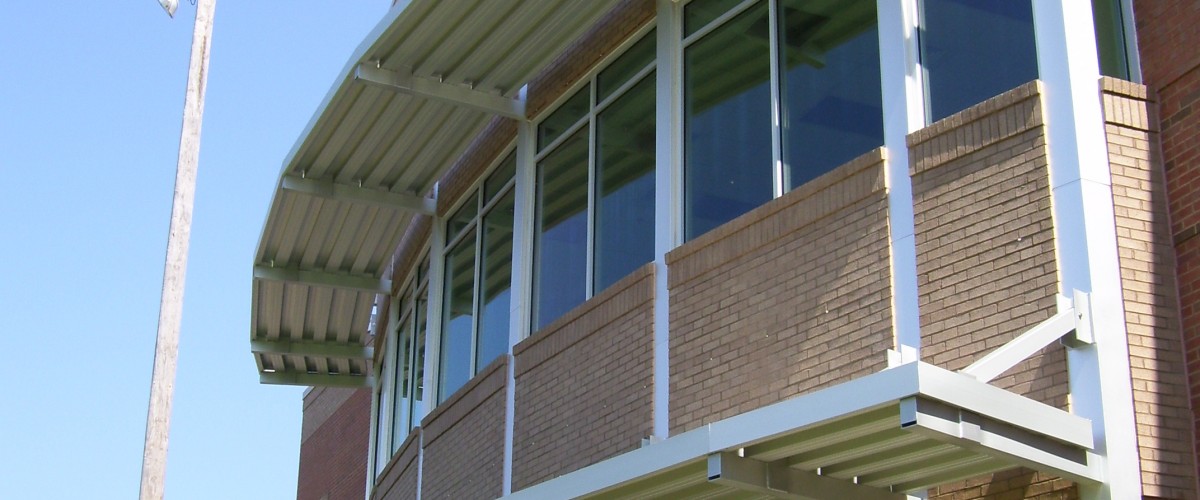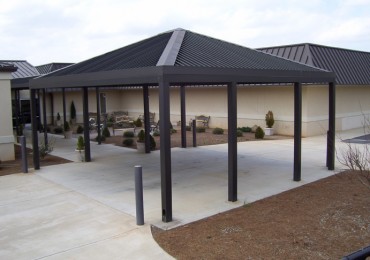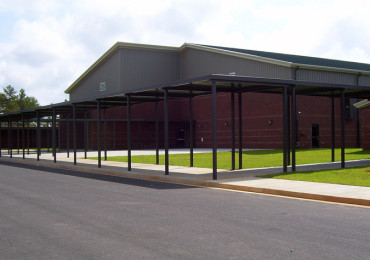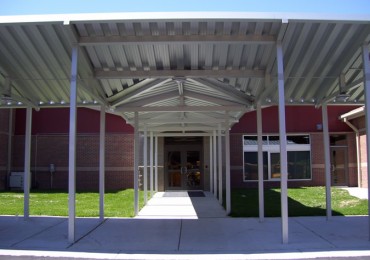Aluminum canopies that are extra wide (13-16’) present a challenge. By the end of this article, you will understand what that challenges are, how we can solve them by using a parallel walkway, and the drawbacks of parallel decking.
Decking for a canopy system can either run parallel or perpendicular to the walkway. At Mitchell Metals, we refer to these two configurations as “long ways” (parallel) and “short ways” (perpendicular).
How Short-Ways Canopy Systems Work
We install short-ways systems with an extruded gutter that runs along the perimeter of the canopy. This is a structural beam that adds lengthwise support and collects the water. The decking runs perpendicular into the gutter, so the gutter provides additional support to the decking as well as drainage capacity. This allows short-ways canopies to withstand up to 12% more water volume compared to the long-ways canopies.
Short-ways systems are installed with draining columns, and can use drain beams when installed up against a wall on one side. This brings water from one side of the canopy (the one against the wall) to the far side, away from the wall.
The only downside of a short-ways system is that the canopy width is limited to allowable decking span. Widths larger than 13 feet are harder to achieve without additional framing. So, in cases where project requirements stipulate a width larger than 13’-0”, we recommend long-ways.
How Long-Ways Systems Work, and their Drawbacks
Because the decking in a long-ways canopy system drains directly into a drain beam, no perimeter gutter is necessary. To give the canopy system a decorative profile, we install a 6”-8” perimeter false fascia along the sides. The natural drainage pattern requires damming of the decking at the ends of the canopy. Damming of the decking to seal it against draingage can be accomplished by either welding sheet metal plates at the ends of the decking, or using sealant and sheet metal plates.
If you are new to aluminum canopies, then see our blog on internal draining for some of the basic advantages aluminum gains over steel systems.
Parallel versus Perpendicular Canopy Systems: When It Rains, It Pours
The long-ways system solves two major design issues. The first is simply a width challenge. Long-ways systems can accommodate canopies larger than 13’-0” wide without additional framing members, which essentially makes them the only kid in town for the larger than 13’-0” range. Architects might also prefer long-ways for the aesthetic appeal of having the decking run with the flow of traffic. But there are some drawbacks:
- When drain holes clog (we say when, not if) due to lack of maintenance, the canopy overflows at the drain beam. This creates a waterfall directly across the walkway. So when it rains, it pours, and it pours all over your traffic. Almost all long-ways canopies that have been installed for 2+ years will have “water marks” at each drain beam showing where they have spilled over in heavy rains.
- Column spacing along the length of the canopy (bay length) is limited to allowable decking spans, whereas the perimeter gutter for a short-ways system can support longer sections
- More challenging for field adjustments – Welded enclosures at the ends mean that all measurements need to be exact. If we have a 20’ long canopy, then we need to weld enclosures on both ends of the 20’ length. But if we go out in the field and find the wall condition is actually 20’ 6”, then all of that decking is fabricated incorrectly and basically worthless. This is an even bigger hurdle with projects involving numerous twists and turns.
- Due to limitations on maximum decking lengths that can be extruded (maximum being 24’-0”), the decking must start and stop above the drain beams. We install T-flashing at these seams to keep them watertight, and this T-Flashing adds additional cost to the project.
Short-ways canopy systems do not have any of these drawbacks. They can be adjusted in the field if measurements are slightly off. The perimeter gutter provides a lot of area for water collection, and any overflow falls along the perimeter of the canopy, which keeps the pathway dry. So even when it fails, the canopy still works the way it was intended.. keeping everyone dry as they travel under the canopy.




